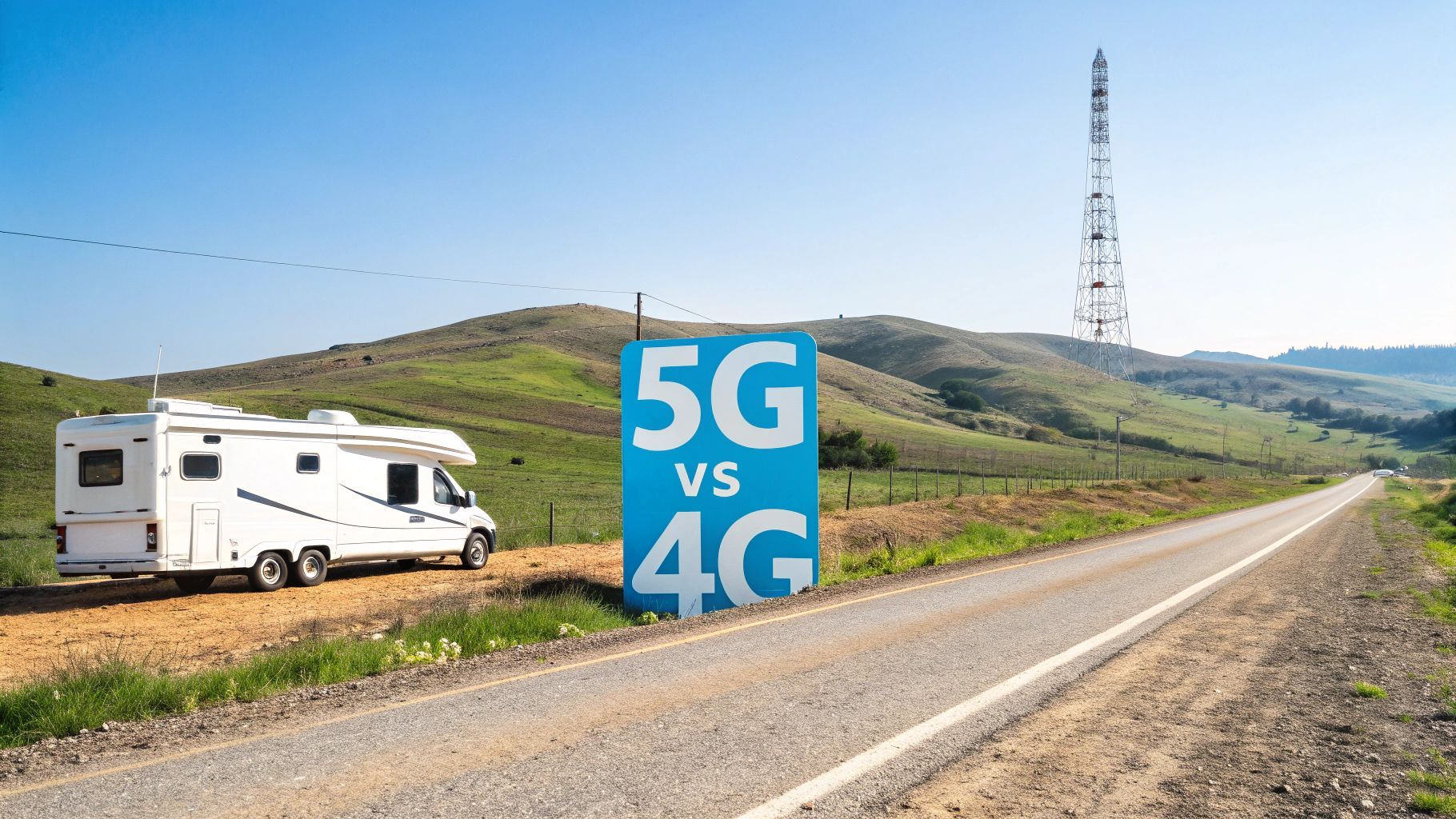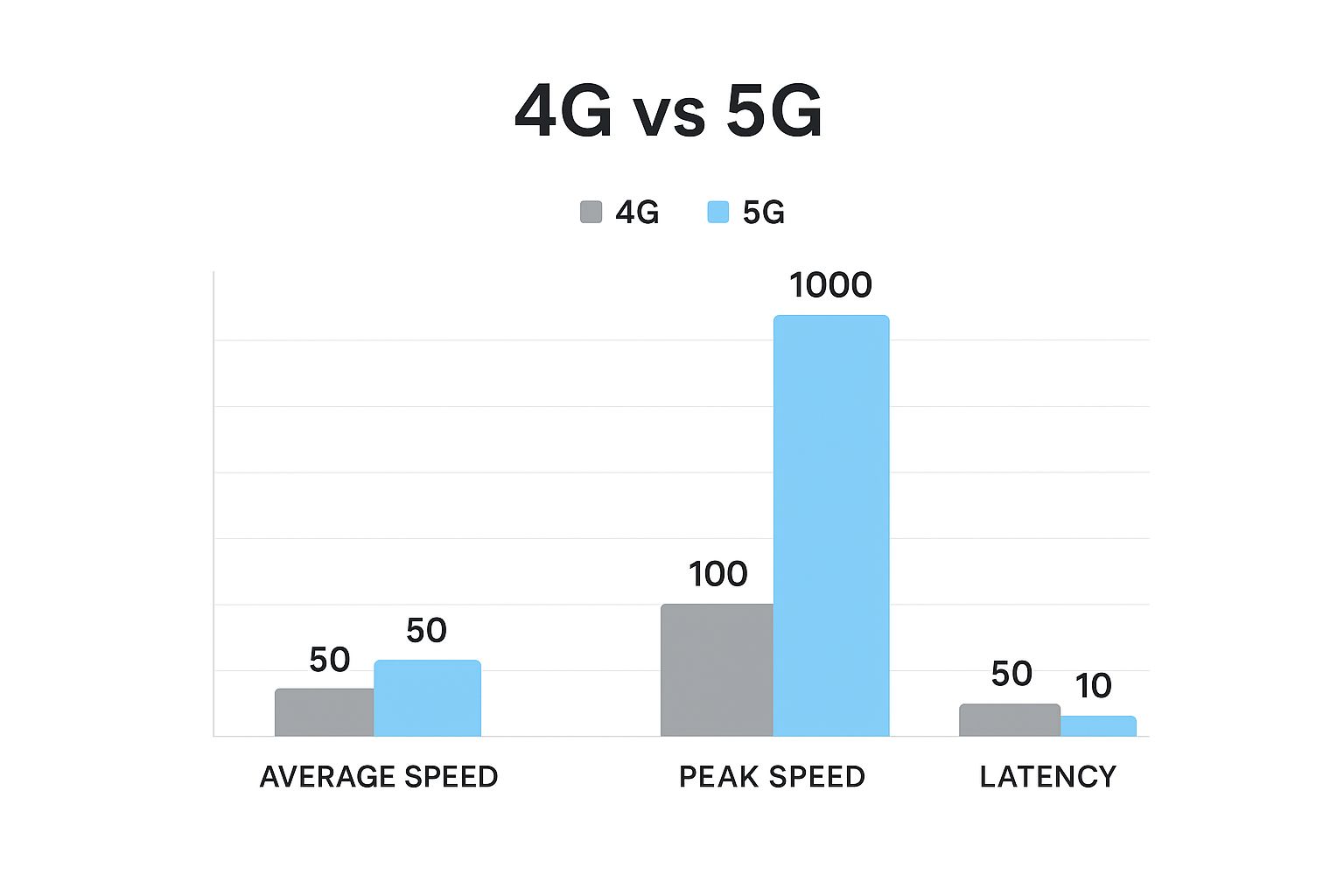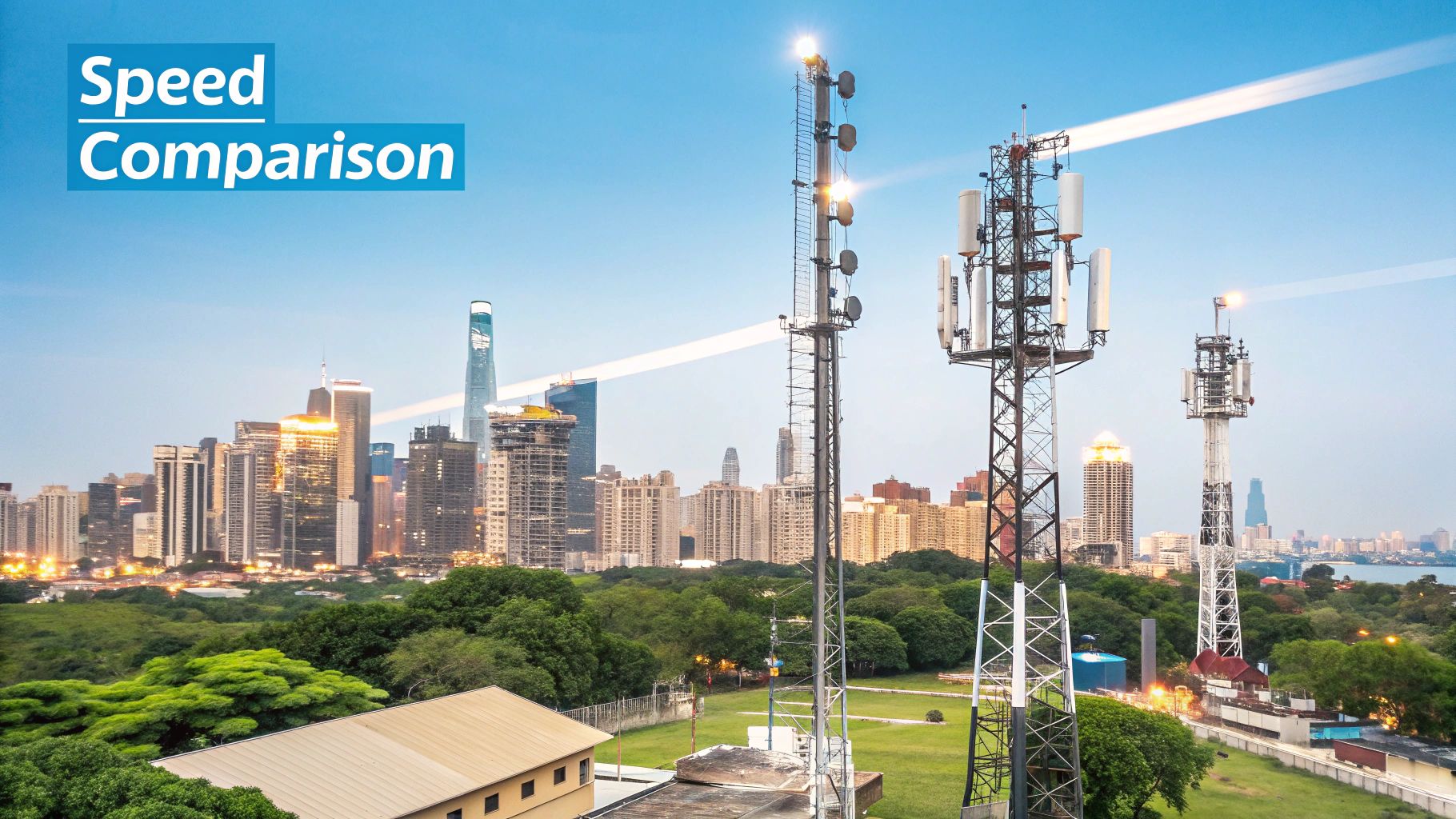

· Por James
5G Speeds vs 4G Real World Performance
When you stack up 5G speeds vs 4G, the main takeaway is pretty simple: 5G gives you a massive speed boost and cuts down lag, while 4G offers that tried-and-true, wider coverage. Your best bet really boils down to what you need more—raw power for heavy-duty tasks or a steady connection just about anywhere you roam.
The Real Difference in 5G vs 4G Performance
To really get the performance gap between 5G and 4G, you have to look past the flashy, best-case-scenario numbers. Sure, 5G is the undisputed speed champion, but what that means for your day-to-day use—especially if you're an RVer or living out in a rural spot—is a bit more complicated. The things that truly shape your experience are speed, latency, and capacity.
This chart gives you a solid visual of the performance you can realistically expect from 4G versus 5G networks.

As you can see, the data makes it crystal clear: 5G has a huge advantage in both peak and average speeds, not to mention a serious drop in latency.
Key Performance Metrics at a Glance
Let's break down the essential differences in a quick-reference table. This gives you a snapshot of how each technology performs in the real world, helping you see where each one shines.
Key Performance Metrics 5G vs 4G at a Glance
| Metric | 4G (LTE) | 5G |
|---|---|---|
| Average Speed | 30-100 Mbps | 150-500 Mbps |
| Peak Speed | Up to 1 Gbps | Up to 10 Gbps |
| Latency (Ping) | 30-50 ms | 5-20 ms |
| Best For | General browsing, HD streaming, widespread coverage | 4K/8K streaming, competitive gaming, remote work with large files |
This table shows that while 4G is more than capable for most everyday activities, 5G is built for the next generation of high-demand applications, from ultra-HD streaming to lag-free competitive gaming.
Global trends are backing up this performance jump. The latest data shows the median global 5G download speed climbed to an impressive 203.04 Mbps in Q3 2023, which is a 20% increase from the year before. Interestingly, upload speeds only nudged up by 1%, which tells you that for now, the big push in 5G development is all about download performance. If you want to dig deeper, you can check out the full worldwide connectivity report for more on these trends.
Key Takeaway: The big deal with 5G isn't just about faster movie downloads; its incredibly low latency is a game-changer. This nearly instant response time makes things like video calls, online gaming, and even smart home devices feel immediate and fluid. It’s a noticeable, tangible upgrade from that slight-but-present delay you often feel on 4G networks.
What Actually Makes 5G Faster Than 4G

The massive performance jump between 5G speeds vs 4G isn't just a simple upgrade—it's a complete technological overhaul from the ground up. This isn't just about making things a little quicker; 5G gets its speed by using the airwaves in a much smarter way, incorporating advanced antenna technology, and running on a more efficient network design.
For anyone trying to get reliable internet in a rural home or an RV, understanding these core differences is crucial. Signal conditions can change in an instant out on the road, and knowing why your connection is behaving a certain way makes all the difference.
A huge part of the magic comes down to how 5G uses radio frequencies. You can think of these frequencies as data highways. 4G primarily operates on a single, often congested highway. 5G, on the other hand, opens up several brand-new, much wider highways for data to travel on.
The Spectrum Advantage
5G operates across a much broader range of radio frequencies, which are broken down into three main bands. Each one strikes a different balance between raw speed and how far the signal can travel, and that balance directly impacts the connection you get in the real world.
- Low-Band 5G: This band uses frequencies similar to what 4G already uses, allowing it to cover huge distances. It's the workhorse of 5G in most rural areas, delivering a solid, noticeable speed boost over 4G LTE, though it won't give you those jaw-dropping speeds you hear about in cities.
- Mid-Band 5G: This is the "goldilocks" spectrum. It's the sweet spot that offers an excellent combination of high speeds and respectable coverage. For most SwiftNet Wifi customers, connecting to a mid-band signal means a major performance leap that's perfect for remote work, HD streaming, and more.
- High-Band 5G (mmWave): This is the ultra-fast express lane, capable of incredible multi-gigabit speeds. The catch? These signals travel very short distances and get easily blocked by things like walls, trees, or even heavy rain. This makes them pretty rare outside of dense urban areas and specific venues like stadiums.
This technological leap is what creates such a dramatic performance gap. While 4G networks can theoretically hit 1 Gbps, real-world speeds are often closer to 20-100 Mbps because of network traffic. In stark contrast, 5G can reach peak speeds from 10 to 20 Gbps in ideal mmWave conditions—a speed increase of up to 100 times faster than a typical 4G connection. If you want to get really technical, you can take a deep dive into the differences between 4G and 5G networks.
Key Insight: A "5G" connection isn't a single experience. The speed you get is entirely dependent on which frequency band your device is connected to. This is why you might get incredible speeds in one spot and more modest, 4G-like speeds just a few miles down the road.
Smarter Antennas and Less Congestion
It's not just about having more frequencies; 5G also uses them far more intelligently. Two key technologies, Massive MIMO and beamforming, work in tandem to give you a stronger and more stable connection.
Massive MIMO (which stands for Multiple Input, Multiple Output) involves packing cell towers with a huge number of tiny antennas. This lets the tower communicate with many more users at the same time without getting bogged down—a game-changer for crowded areas like a busy RV park or a rural town during a festival.
Beamforming then works with all those antennas to focus the wireless signal directly at your device instead of just broadcasting it out in every direction. It’s like the tower is switching from a wide, dim floodlight to a powerful, targeted spotlight. This creates a more direct and efficient link, which cuts down on interference and boosts your speed.
How Network Speeds Vary Across The Globe

When we talk about 5G speeds vs 4G, it’s crucial to understand that these aren't universal numbers. The zippy 5G you’d get in a bustling South Korean city feels worlds apart from the signal you might find in a quiet American town. It’s a classic case of "your mileage may vary."
This gap in performance doesn't just come down to the tech itself. It’s really a story about infrastructure investment, population density, and even government priorities. The speed you get is a direct reflection of a country's commitment to building out its network, which is why your personal connection might not live up to the blazing-fast speeds you see in headlines. Your experience is hyper-local, defined entirely by the towers in your immediate area.
The Global 5G Leaders
A few nations have absolutely sprinted ahead in the 5G race, giving us a clear picture of what’s possible when the rollout is a top priority. These countries set the benchmark for what next-gen wireless can do when it's fully backed by investment and infrastructure.
South Korea, for instance, is consistently at the top of the leaderboard. People there enjoy some of the fastest average 5G download speeds on Earth, making things like 4K streaming and cloud gaming feel instantaneous and rock-solid. They've set a high bar for what other countries are striving to achieve.
Global Reality Check: Think of your 5G speed as a postcode lottery. It all boils down to how much local carriers have invested in upgrading the network right where you are, not just the national averages.
This regional difference is a big deal for SwiftNet Wifi customers, especially those on the move in an RV. The gap between a strong 4G signal and a still-developing 5G network can make or break your connectivity on the road. It’s why understanding the real-world challenges of providing reliable internet access for rural areas is so important for setting the right expectations.
In markets with aggressive rollouts, the leap from 4G to 5G is nothing short of staggering. In mid-2023, India's average 5G download speed was a massive 19.2 times faster than its 4G. Malaysia saw a 14.4 times jump, and Brazil wasn't far behind at 13.5 times faster.
For raw performance, look no further than South Korea, where the average 5G download speed clocked in at an incredible 432.5 Mbps. You can dig into more of these numbers in this global 5G experience benchmark report.
How 5G Transforms Your Daily Digital Life

The raw numbers behind 5G speeds vs 4G are impressive on paper, but what do they actually mean when you're just trying to get things done? The real magic happens when you see those megabits per second translate into tangible, real-world experiences. It's what separates technology that just works from technology that feels completely effortless.
With 4G, you could stream HD video, sure. But you probably also dealt with buffering during peak hours or watched the quality drop if someone else in the RV started a video call. On 5G, streaming in 4K or even 8K becomes the new normal, with enough bandwidth to handle multiple high-def streams at once without a single stutter. It’s a direct result of 5G’s ability to handle way more traffic without getting congested.
For anyone working remotely, especially digital nomads, this upgrade is a game-changer. A stable connection isn't just a nice-to-have; it's a must-have. 5G delivers a level of reliability that was often a pipe dream on 4G, particularly in crowded RV parks or areas with spotty signals.
From Frustrating to Fluid Experiences
Think about the tasks that always seemed to push your 4G connection to its breaking point. Those are the exact areas where 5G really flexes its muscles, turning painful waits into seamless operations.
- Large File Transfers: Remember that sinking feeling of watching a progress bar crawl for minutes—or even hours—while uploading a big project file or a folder of high-res photos? With 5G, those same files can be sent in just a few seconds. For professionals living on the cloud, this isn't a luxury; it's a necessity.
- Video Conferencing: A group video call on 4G could quickly turn into a pixelated, laggy mess where you're constantly asking, "Can you hear me now?" 5G’s powerful combination of high bandwidth and low latency keeps your video and audio crystal clear, making virtual meetings feel much closer to being in the same room.
- Competitive Online Gaming: For gamers, latency is everything. The 30-50ms latency of 4G was okay for casual play, but 5G’s potential to dip below 10ms completely eliminates the input lag that can mean the difference between winning and losing.
For SwiftNet Wifi customers, especially those traveling in an RV, this means you can finally stop planning your workday around finding that one perfect spot with a flawless signal. 5G delivers the robust performance you need to run your remote office from almost anywhere a signal reaches.
Powering a Connected Lifestyle on the Move
Beyond just work and entertainment, 5G truly unlocks a more connected lifestyle. Think about running a smart RV or a connected rural home. With 4G, adding just a few too many smart devices—like security cameras, thermostats, and speakers—could slow your entire network down to a crawl.
5G's massive capacity means it can support a huge number of connections at the same time without even breaking a sweat. You can have dozens of smart devices running, stream 4K content on your TV, and have multiple people working online without ever noticing a drop in performance. This capability finally turns the promise of a truly connected home—even a mobile one—into a practical reality.
Why 5G Latency Is a True Game Changer
While most of the buzz around 5G vs 4G speeds gets caught up in massive download numbers, 5G’s real secret weapon is its dramatically lower latency. You can think of latency as the network's reaction time—the technical term for lag or delay. A fast download speed is like having a wide-open highway, but low latency is like having a sports car with instant acceleration on that same road.
Ever tell a joke on a video call and have to sit through that awkward pause before the other person finally laughs? That's latency. For a competitive online gamer, it’s the input lag that costs you the match. 4G networks typically clock in with a latency around 30-50 milliseconds (ms). 5G was engineered from the ground up to crush that number, aiming for under 10 ms and, in ideal lab conditions, as low as 1 ms. This creates a feeling of instant response that just wasn't possible before.
The Impact of Near-Zero Lag
This snappy, near-instantaneous feedback has a huge impact on pretty much everything you do online. It's what makes a remote work meeting feel crisp and natural, without people accidentally talking over each other because of signal delays. For RVers who depend on a solid connection to get their work done, this kind of stability can be a complete game-changer.
The jump from 4G to 5G latency isn’t just a small step up; it’s a fundamental shift. This ultra-low delay unlocks experiences that need real-time feedback, making every interaction feel fluid, responsive, and immediate.
Take cloud gaming, for instance. Your controller inputs are shot off to a remote server, which then streams the game's video right back to you. With 5G, that whole process can feel just as responsive as playing on a console sitting right in front of you. The same idea applies to future tech, like real-time augmented reality (AR) apps that seamlessly interact with the physical world. If you're curious about how this applies to connecting in harder-to-reach spots, our guide on rural 5G internet boosting remote connectivity dives in deeper.
Ultimately, while faster speeds are fantastic for grabbing big files, it’s the low latency that truly improves the quality of every single online interaction. It’s the key that makes our digital lives feel more human and less robotic, paving the way for a new wave of applications that count on split-second communication.
Choosing the Right Connection for Rural and RV Life
When you live or travel outside of the big cities, the whole 5G speeds vs 4G debate gets a lot more real. It stops being about hitting those mind-blowing peak speeds you see in commercials and starts being about one simple thing: finding a connection that just works day in and day out. While 5G is the future, the truth is that in many rural spots and remote campgrounds, a solid 4G LTE signal is still your most reliable friend.
For any SwiftNet Wifi user, whether you're set up in a farmhouse or rolling down the highway in an RV, the main question is consistency over raw power. Is it better to have a sometimes-on, sometimes-off 5G signal that's blazingly fast when it works, or a steady, widespread 4G connection? The answer really comes down to where you are and what you're doing, blowing up the myth that 5G is always the winner.
Situational Realities on the Road
For those of us in the RV community, the connectivity map changes with every single mile marker. One night you might be in a park with fantastic 5G, and the next day you’re deep in a 4G-only zone. That constant change is exactly why 4G's wider reach is such a huge plus. A stable 4G signal is more than enough for streaming a movie in HD, knocking out emails, and general web browsing.
But, if your job involves uploading massive files or you need crystal-clear video calls to make a living, then hunting for spots with verified 5G coverage becomes part of the travel plan. This is where a little bit of prep work can save you a major headache.
The Rural Rule of Thumb: A strong, stable 4G signal will almost always beat a weak, unreliable 5G signal. Always prioritize connection stability for the important stuff like work and staying in touch, especially when you're on the move.
Making an Informed Decision
The single most important step you can take is to figure out what’s actually available at your specific location. Carrier coverage maps are a decent place to start, but let's be honest, they don't paint the full picture. Those maps show where a signal might be, not the real-world performance you'll get inside your house or RV.
This is where your gear can be a total game-changer. An external antenna can turn a weak, borderline-useless signal (4G or 5G) into a strong, dependable connection. By grabbing the signal from outside and feeding it straight to your router, you sidestep all the stuff that kills your speed, like metal walls and thick trees.
Ultimately, picking between 4G and 5G in a rural or mobile setting isn’t a one-and-done choice; it's something you decide based on your situation. You have to look at what you need to do online right now and what the local towers can give you. For a deeper dive into this, our guide on finding the best internet for remote locations in 2025 is packed with practical tips to keep you connected, no matter where the road takes you.
Answering Your Top 5G vs 4G Questions
Let's cut through the jargon. When you're thinking about upgrading your internet, especially for life on the road or in a rural spot, you just want straight answers. We get a lot of questions about what the whole 5G speeds vs 4G debate really means for everyday use. Here are the most common ones we hear.
Do I Need a New Device for 5G?
Yes, you absolutely do. To tap into 5G networks, you need a device—whether it's a phone, a mobile hotspot, or a dedicated router like the ones we offer at SwiftNet Wifi—that's built for it from the ground up.
Your current 4G-only gear simply doesn't have the right internal hardware. The specific modems and antennas needed to pick up and translate 5G signals are missing. It's not something a simple software update can fix; it's a physical hardware requirement.
Is 5G Available Everywhere 4G Is?
Not even close. For our customers who are RVing or living in the countryside, this is probably the most important thing to understand. While 5G is spreading quickly, the old reliable 4G LTE network still has a massive head start, offering much wider and more dependable coverage across the nation.
Key Insight: I like to think of 4G as the vast, comprehensive highway system that connects almost every town. 5G, on the other hand, is the brand-new, blazing-fast express lane that’s still being built out. You'll find it mostly in and around cities, with rural access slowly but surely getting better.
When Does Sticking with 4G Make Sense?
Honestly, sticking with a solid 4G connection is often the smarter move in a few very common situations. If you're in a place where you get a strong, steady 4G signal but 5G is spotty or nonexistent, 4G is going to give you a much more stable and less frustrating experience.
Also, think about what you actually do online. If your current 4G connection handles your day-to-day needs—like streaming shows in HD, browsing the web, and working remotely—without a hitch, there’s no urgent need to chase the 5G dragon. For many people, a powerful and consistent 4G signal is far better than a weak or flaky 5G one.
Ready to see if a high-speed 5G connection can transform your remote work or travel experience? Explore the powerful and reliable internet solutions from SwiftNet Wifi and find the perfect plan for your needs.

